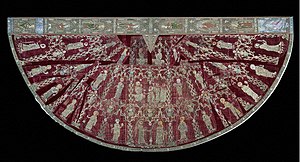
The Victoria and Albert Museum in London is the world's largest museum of applied arts, decorative arts and design, housing a permanent collection of over 2.8 million objects. It was founded in 1852 and named after Queen Victoria and Prince Albert.

The Raphael Cartoons are seven large cartoons for tapestries, surviving from a set of ten cartoons, designed by the High Renaissance painter Raphael in 1515–16, commissioned by Pope Leo X for the Sistine Chapel in the Vatican Palace. The tapestries show scenes from the Gospels and Acts of the Apostles and are hung below the frescoes of the Life of Christ and the Life of Moses commissioned by Pope Sextus. The cartoons belong to the British Royal Collection but since 1865 are on loan to the Victoria and Albert Museum in London.

The Crown Jewels of the United Kingdom, originally the Crown Jewels of England, are a collection of royal ceremonial objects kept in the Jewel House at the Tower of London, which include the coronation regalia and vestments worn by British monarchs.

Filigree is a form of intricate metalwork used in jewellery and other small forms of metalwork.

Dorris Estelle Bowdon was an American actress, best known for her role as Rosasharn in The Grapes of Wrath.
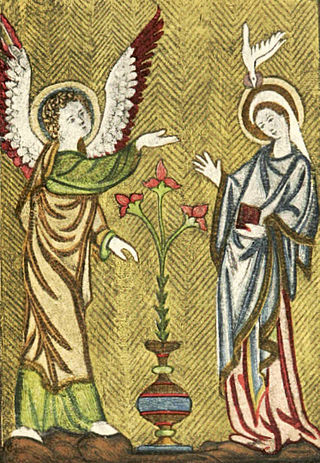
Opus Anglicanum or English work is fine needlework of Medieval England done for ecclesiastical or secular use on clothing, hangings or other textiles, often using gold and silver threads on rich velvet or linen grounds. Such English embroidery was in great demand across Europe, particularly from the late 12th to mid-14th centuries and was a luxury product often used for diplomatic gifts.

Dame Lucie Rie, was an Austrian-born, independent, British studio potter working in a time when most ceramicists were male. She is known for her extensive technical knowledge, her meticulously detailed experimentation with glazes and with firing and her unusual decorative techniques.
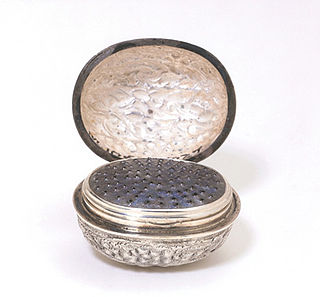
A nutmeg grater, also called a nutmeg rasp, is a device used to grate a nutmeg seed. Nutmeg graters are normally metal, cylindrical or half-cylindrical, the surface perforated with small rasped holes. The nutmeg is passed over the surface to grate. The grater may be combined with a compartment for storing the nutmeg seed between uses.

Bowden Hill is a village in Wiltshire, England, in Lacock parish about 3+1⁄2 miles (6 km) south of Chippenham and 1+1⁄2 miles (2.4 km) to the east of Lacock village. Bowden Hill has about 50 houses, a pub, and a small industrial estate.

The Gloucester Candlestick is an elaborately decorated English Romanesque gilt-bronze candlestick, now in the Victoria and Albert Museum in London. It was made for Gloucester Cathedral between 1104 and 1113, and is one of the outstanding survivals of English Romanesque metalwork.

Margaret Layton's jacket is a surviving example of English Jacobean embroidery, significant because it appears in a portrait which has also survived. The jacket was originally owned and worn by Margaret Layton (1579–1641), wife of Francis Layton (1577–1661) who was one of the Yeomen of the Jewel House during the reigns of James I, Charles I and, briefly, Charles II. Embroidered linen jackets were worn as informal dress, and were particularly popular among wealthy women in the late sixteenth and early seventeenth centuries. This jacket is exquisitely decorated with flowers, birds and butterflies, embroidered in coloured silks, coiled tendrils of silver-gilt plaited braid stitch and silver-gilt sequins. The edges of the jacket are trimmed with silver and silver-gilt bobbin lace and silver-gilt spangles.

English embroidery includes embroidery worked in England or by English people abroad from Anglo-Saxon times to the present day. The oldest surviving English embroideries include items from the early 10th century preserved in Durham Cathedral and the 11th century Bayeux Tapestry, if it was worked in England. The professional workshops of Medieval England created rich embroidery in metal thread and silk for ecclesiastical and secular uses. This style was called Opus Anglicanum or "English work", and was famous throughout Europe.

A fish slice is a kitchen utensil with a wide, flat blade with holes in it, used for lifting and turning food while cooking. It may be called a slotted spatula or a turner or flipper. The utensil was originally designed as a serving piece rather than a cooking implement.

Bizarre silks are a style of figured silk fabrics popular in Europe in the late 17th and early 18th centuries. Bizarre silks are characterized by large-scale, asymmetrical patterns featuring geometrical shapes and stylized leaves and flowers, influenced by a wave of Asian textiles and decorative objects reaching the European market in these decades. Bizarre silks were used for both clothing and furnishings. As a description, the term was first used by Dr. Vilhelm Sloman in the title of a book, Bizarre Designs in Silks published in 1953 in Copenhagen.

A toilet service is a set of objects for use at the dressing table. The term is usually reserved for large luxury sets from the 17th to 19th centuries, with toilet set or vanity set used for later or simpler sets. Historically, services were made in metal, ceramics, and other materials, for both men and women, though male versions were generally much smaller. The rich had services in gold, silver, or silver-gilt. The contents vary, but typically include a mirror, one or more small ewers and basins, two candlesticks, and an assortment of bowls, boxes, caskets, and other containers. One or more brushes and a pin-cushion, often as a top to a box, are often included. The sets usually came with a custom-made travelling case, and some services were especially designed for travelling.
Philippa Jane Glanville , OBE, FSA, formerly chief curator of the metal, silver and jewellery department of the Victoria and Albert Museum, is an English art historian who is an authority on silver and the history of dining.
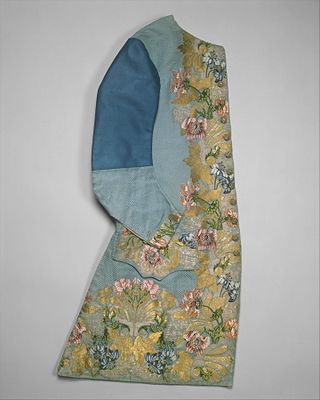
A man's waistcoat with sleeves of 1747 is a rare example of eighteenth century clothing for which the garment itself, the original textile design, and a dated record of both the designer and the master weaver who made the fabric have also survived. The waistcoat is part of the collection of the Costume Institute at the Metropolitan Museum of Art in New York, number C.I.66.14.2.

The Aldobrandini Tazze are a set of 12 silver-gilt standing cups in the shallow tazza shape, sometimes described as bowls or dishes. They are outstanding examples of Renaissance metalwork, described by John Hayward as "the most impressive single monument of Italian and perhaps European goldsmith's work of the 16th century", and by the Victoria and Albert Museum as "one of the most spectacular groups of 16th century silver to survive".

The Steeple Aston Cope is a cope made between 1320 and 1340. It is notable for being one of the few surviving examples of English medieval embroidery, and is the earliest known depiction of a lute in England. It was made with silk, silver and gold threads.
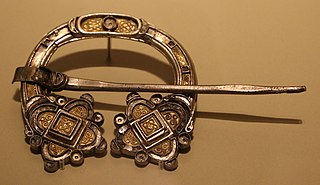
The Kilmainham Brooch is a late 8th- or early 9th-century Celtic brooch of the "penannular" type. With a diameter of 9.67 cm, it is a relatively large example, and is made from silver, gold and glass, with filigree and interlace decorations. Like other high-quality brooches of its class, it was probably intended to fasten copes and other vestments rather than for everyday wear, as its precious metal content would have made it a status symbol for its owner; less expensive Viking-style brooches were typically worn in pairs on women's clothing.
